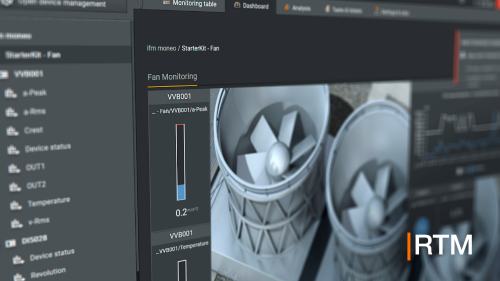Level monitoring with replenishment control for a potting plant
Visualisation and analysis of levels with moneo RTM and control of internal logistics processes
Resin and hardener together form the casting resin; a key component in sensor production. Potting with these materials helps to protect the electronics from shock, vibration and moisture.
The availability of resin and hardener in casks is essential for maintaining the reliability and quality of the products during the production process. Therefore, the levels of the resin and hardener casks are to be monitored. Moreover, the internal logistics processes for replenishing materials are to be automated.
The starting position
Until now, the internal plant control system has monitored the current level of the casks containing the components. A necessary cask change is indicated by a signal lamp. Material for replenishing the plant must be actively requested by mail from the central warehouse. An automated replenishment control does not exist.
Yet another problem was that some materials were provided too early. This led to material being used beyond its actual expiry date.
Furthermore, resin and hardener must acclimatise to the production environment before use. During colder months, in particular, the short-notice delivery of material led to various issues, especially if there was insufficient time for it to adjust to the ambient temperature.
Goal of the project
The objective now is to establish a demand-oriented provision of raw materials at the plant. This includes level monitoring of the casks. Furthermore, the idea is to introduce an automated ordering process for the replenishment of raw materials to ensure their availability at the point of use.
Implementation
The moneo RTM software is centrally installed on a server. The IO-Link master is connected to the server via an internal VLAN within the IT network of the company. The level sensors are connected to the IO-Link master via IO-Link.
The level sensors are already installed in the plant and transmit the current level to the plant control system. To ensure that this use case can be implemented without impacting the original plant control system, the Y path is used.
moneo RTM is connected to the SAP MM module* and the SAP PM module** via the SFI interface. moneo RTM sends defined alarms / events to SAP via the SFI interface. Depending on the actual process, further processing is carried out in the SAP MM or PM module.
A threshold violation starts the order request process in the central warehouse several kilometres away. This process ends with the material being available in production, while the level sensor indicates that the cask is once again full. This is referred to as SFI replenishment control.
*SAP MM module = "Material Management" module for planning and controlling the flow of materials within a company
**SAP PM module = "Plant Maintenance" module for managing all maintenance and servicing orders within a company
Success
- Process optimisation from time-based maintenance to the control of internal logistics processes
- Connection to the SAP system via SFI interface
- Automated, internal reordering of raw materials in SAP via SFI replenishment control
- By capturing sensor values and utilising moneo software, detailed information about levels can be recorded and clearly visualised
- Fast response to changing process parameters through integrated alarm management
- Refilling of media as required through automated replenishment processes
- Identification of threshold overshooting and undercutting
- Optimised plant utilisation by ensuring machine availability and increasing process quality
- Conversion of sensor values into process-relevant information using data modelling (calculated values)
System structure
Two casks, each equipped with one level sensor, are used in the application. As such, components 3 and 4 are required twice.

Dashboard
The dashboard provides the user with an overview of all relevant process values.

- Current tank level in mm
- Traffic light display for warning and alarm value of the level
- Current tank level in litres
Analysis
The analysis makes it possible to observe the previous consumption in the history. This allows conclusions to be drawn about the capacity utilisation of the plant. Furthermore, it is possible to estimate the expected lifespan of a cask. This acquired knowledge can assist internal logistics in consistently optimising the provision of materials.

Ticket processing rules
Values for the lower and upper warning and alarm thresholds are defined for each of the two level sensors. These values are based on maintenance experience.

- Upper warning = resetting all the tickets after replacing the cask
- Lower warning = re-ordering and providing a new cask at the plant
- Lower alarm = replacing the cask in the plant
Manage ticket processing rules
The ticket processing rules wizard makes it easy to define actions to be executed when warnings and alarms occur.
In the following case, ticket processing is carried out via the SFI interface to the SAP MM and PM module. If the level drops below the threshold, the SFI interface relays the threshold violation to the SAP MM or PM module parallel to the message in moneo. In this case, the replenishment control process is triggered automatically.

Connection of moneo to the SAP system
- Address of the SAP/SFI server
- Port of the SAP SFI server
- SAP/SFI user
- SAP/SFI user password

Configuration of the ticket processing rule
- Defines which rule is applied
- Definition of the thresholds (4) and data sources (5)
- Defines the urgency of warnings or alarms
- Definition of the relevant thresholds
- Definition of the corresponding data sources
Message in the SAP system

Material document in the SAP MM module

Maintenance order in the SAP PM module
SFI replenishment control
The SFI replenishment control is used to automatically request and provide consumables. If the defined lower warning threshold of a cask is undercut, a warning ticket is created in moneo. This ticket is forwarded to the SAP system by the ticket processing rule that has been set up. In this case, it is the SAP MM module. A document is generated automatically, requesting the prompt provision of the required material.
This document is processed in the central warehouse, from where the corresponding material is transported to the picked items location. If the lower alarm threshold is now undercut, the person in charge of the plant can promptly replace the empty cask with the provided full cask. To ensure correct detection of a cask change, the upper warning threshold of the casks is also monitored. If the upper threshold is overshot, moneo and the SAP MM module resolve the initial violation of the lower threshold.
To prevent threshold violations during a cask change or other maintenance work, an optical sensor monitors the closure status of the door behind which the two casks are located. If the door is opened, the process value of the sensor is overwritten as long as the door remains open. This was achieved with the Data Flow Modeler function.

- Upper warning threshold
- Lower warning threshold
- Lower alarm threshold
- The cask is full
- The contents of the cask are consumed during the production process
- The level reaches the lower warning threshold
- A ticket is generated in moneo and transmitted from the SAP system via the SFI interface. Simultaneously, the ticket regarding overshooting of the upper warning threshold during the previous cask change is resolved
- New material is requested within the SAP system and generates a ticket in the ifm central warehouse
- New material is transported by the ifm logistics service to the picked items location.
- The level reaches the lower alarm threshold
- A ticket is generated within moneo and the person in charge of the plant is informed about a necessary cask change via the SAP PM module
- The empty cask is replaced with the provided full cask.
- The level therefore reaches the upper warning threshold when changing the cask
- When the upper warning threshold is reached, the ticket of the lower warning threshold violation is resolved
Calculated values
The following value is additionally calculated based on the level.
Current tank level in litres
Since the floor space of the cask is known, the fill quantity can be easily determined by using the formula “floor space x level”.

- Current tank level in mm
- Factor for converting the unit of the data source, here 1 = mm
- Base area of the tank in mm²
- Factor for converting the unit of the output, here 1,000,000 = litres
- Scaling of the unit in mm
- Base area in mm² multiplied by level in mm = volume in mm³
- Scaling of the output unit from mm³ to litres (dm³)
- Volume in litres as result of the calculation
Process value bypassing with the door open
The data flow model outlined below is used for door monitoring to mitigate the risk of incorrect ordering resulting from inadvertent threshold triggering during a cask change or maintenance work on the cast resin casks:

- Current tank level in mm (input value)
- Fixed constant by which the output value is to be bypassed
- Trigger input to activate the bypass
- Function block “double to boolean” - conversion of the numerical value to a bool value: true = 1 / false = 0
- Function block “signal switch” input “A” is output as soon as the toggle input is “false=0” or input “B” is output as soon as the toggle input is “true=1”.
- Result (output value)



